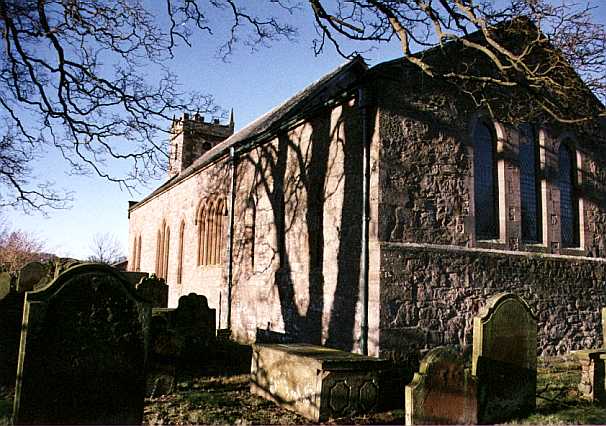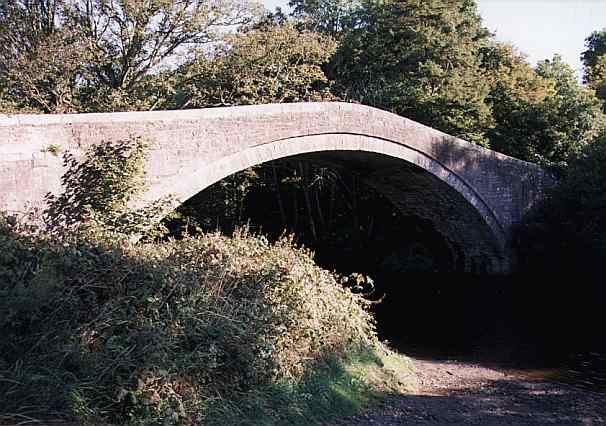Sebergham1 village, or, as it
is commonly called, Sebergham Church Town, occupies a pleasant situation, near the river
Caldew, in High Bound township, 2½ miles N. by E. of Hesket New Market, eight miles S.E.
of Wigton, and 10 miles S. by W. of Carlisle. Mr. Denton says, "Sebergham is so
called of the place where it stands, which is a hill, or rising ground, in the forest of
Englewood; which, of the west side, was dry ground, or woodland; but the north-east side a
wet spongy earth, covered with rushes, which the country people call Sieves, - and
thereupon the place was called Seevy-burgh." But Hutchinson says, "a more
simple etimology is obtained by the natural and obvious terms sun and sea,
which, in this county at least, are (and in distant times were also in many others)
equivalent to north and south;" and that "Berg is the well-known Saxon
term for an hill, as ham, or hame, also is for a place of abode, or permanent
residence." William Wastall, an hermit, lived here to an extreme old age,
in the reigns of Henry I and II. He came thither in the former reign, and died about the
end of king John's time, after having enclosed and cultivated the adjacent lands, which,
at the Conquest, was a great waste or wilderness. King John granted him "the
Hill," which he left to the prior of Carlisle, so that it now belongs to the dean and
chapter, and is called Sebergham manor; but that part of the parish which was
formerly common land, forms a manor of the same name, under the Duke of Devonshire, whose
tenants pay a free rent of 6d. an acre. Here are also three small mense manors,
called Warnell Hall, of which the Earl of Lonsdale is lord, Parson's Park,
belonging to the Rev.  James Lynn, rector of Caldbeck, and Hart Rigg,
belonging to John P. Fletcher, Esq., who also owns Sebergham Castle, a large farm house,
about two miles W. from the village. The Church, dedicated to the Blessed Virgin, is a
neat fabric, "and stands pretty near the centre of this circular parish," on the
very spot, as is supposed, where William Wastall, the hermit, had his cell, and the first
erection of a church here is probably coeval with his bequest already noticed. It was
thoroughly repaired, and a gallery erected in 1774; and in 1785, the chancel was again
repaired. The parsonage house, which adjoins the church, was rebuilt in 1773, on the site
of an old one. It is tolerably commodious, but, at present stands in need of repairs. The
living is now a perpetual curacy, in the patronage and appropriation of the dean and
chapter of Carlisle. In 1771, the tithes were commuted for a fixed quantity of wheat,
viz., 267 Winchester, equal to 89 Carlisle bushels; and, in the same year, a modus or
prescription of £9 0s. 8½d., was settled by an Act of Parliament, to be paid in lieu of
the corn and hay tithes of the ancient land, to the curate, who has also about 80 acres of
glebe or church land, 36 of which were awarded at the enclosure, and 16 belong to the dean
and chapter, for which he pays a small yearly rent; the remainder was purchased with £400
obtained from Queen Anne's bounty, £200 given by John Simpson, Esq., and a parochial
contribution, so that the benefice is now worth upwards of £140 per annum, and is enjoyed
by the Rev. Clement Moody, M.A., M.H.O. Near to the church is a school built a few years
ago.
James Lynn, rector of Caldbeck, and Hart Rigg,
belonging to John P. Fletcher, Esq., who also owns Sebergham Castle, a large farm house,
about two miles W. from the village. The Church, dedicated to the Blessed Virgin, is a
neat fabric, "and stands pretty near the centre of this circular parish," on the
very spot, as is supposed, where William Wastall, the hermit, had his cell, and the first
erection of a church here is probably coeval with his bequest already noticed. It was
thoroughly repaired, and a gallery erected in 1774; and in 1785, the chancel was again
repaired. The parsonage house, which adjoins the church, was rebuilt in 1773, on the site
of an old one. It is tolerably commodious, but, at present stands in need of repairs. The
living is now a perpetual curacy, in the patronage and appropriation of the dean and
chapter of Carlisle. In 1771, the tithes were commuted for a fixed quantity of wheat,
viz., 267 Winchester, equal to 89 Carlisle bushels; and, in the same year, a modus or
prescription of £9 0s. 8½d., was settled by an Act of Parliament, to be paid in lieu of
the corn and hay tithes of the ancient land, to the curate, who has also about 80 acres of
glebe or church land, 36 of which were awarded at the enclosure, and 16 belong to the dean
and chapter, for which he pays a small yearly rent; the remainder was purchased with £400
obtained from Queen Anne's bounty, £200 given by John Simpson, Esq., and a parochial
contribution, so that the benefice is now worth upwards of £140 per annum, and is enjoyed
by the Rev. Clement Moody, M.A., M.H.O. Near to the church is a school built a few years
ago.
The township of Sebergham High Bound contains
3,224 acres rated at £2,670 10s. and the principal landowners, besides the resident
yeomen, are the Earl of Lonsdale, John Philip Fletcher, Esq., George Dixon, Esq., Mr.
William Mattinson, and the Rev. George Dew, the latter of whom owns Sebergham Hall,
a good building, a little north of  the church. Sebergham Bridge2 is a hamlet, delightfully situated, on both sides of the
bridge, which here crosses the Caldew, and which was built in 1689, by Alexander Denton,
Esq., Justice of the Common Pleas. Here are extensive bleach works, and two corn
mills, one of which is in the parish of Castle Sowerby. Bell Bridge, about a mile lower
down the river, consists of one lofty arch, erected in 1772, on the site of a very feeble
one, which was swept away by a great flood in 1771.
the church. Sebergham Bridge2 is a hamlet, delightfully situated, on both sides of the
bridge, which here crosses the Caldew, and which was built in 1689, by Alexander Denton,
Esq., Justice of the Common Pleas. Here are extensive bleach works, and two corn
mills, one of which is in the parish of Castle Sowerby. Bell Bridge, about a mile lower
down the river, consists of one lofty arch, erected in 1772, on the site of a very feeble
one, which was swept away by a great flood in 1771.
Newlands and Warnel are two other hamlets in this township, the former one mile N.E. of Hesket New Market, and the latter 1½ mile W. by N. of Sebergham. Warnel Hall, now a farm house, was long the seat of the Dentons, and formerly belonged to the Dacres, of Gilsland; but is now the property of the Earl of Lonsdale. The demesne contains about 600 acres. Near the west end of the hall there was once a strong tower, traditionally said to have been built by a Scotch nobleman, as the condition of his ransom, when taken prisoner by one of the Dentons at the battle of Flodden Field, in 1513. There was also a large beacon on the same ground. "It was from the circumstance of this beacon, or this tower, or both, that the place is supposed, and with good reason, to have got its name Warnell, having originally been Warn-Hill." At a place called the Iron Gill, near Warnel, is a chalybeate spring. Population, in 1841, 495.
Sebergham Low Bound contains the hamlets of Upper and Nether Welton3, the former eight, and the latter seven miles S. by W. of Carlisle, and about 2,000 acres of land, rated at £1,345. The soil belongs to various owners, amongst whom are the Messrs. Simpson, Connell, and Lee. Burns-Hill House is a good mansion, in a pleasant situation, about half-a-mile from the church, overlooking the banks of the Caldew. It is the property and residence of James Heysham, Esq., and was erected about nine years ago. Population, in 1841, 385.
Biography -The Rev. Josiah Relph, "the past'ral bard of Cauda's4 Vale," was born at Sebergham Church Town, in 1712, of humble but respectable parents. He was educated at Appleby school and Glasgow university, and was many years curate and schoolmaster in his native village; where he inculcated amongst the inhabitants that esteem for learning which, Hutchinson says, "travellers, even of the present day, observe in a people whose ancestors were tutored by Relph." His miscellaneous volume of poems, in the Cumberland dialect, has passed through several editions. He was an inimitable delineator of the "passions and customs operative on low life;" and his description of the innocent loves of the Damons and Cloes of the vale of Sebergham is very accurate. He died, unmarried, in the prime of life (it is said, from actual want of the necessaries of life), June 17th, 1743, at the place of his nativity; and lies buried in Sebergham church yard.
The Rev. Thomas Denton - who was born at Sebergham, in 1724, and received his school education under Mr. Relph - published a number of excellent poems, and edited the supplementary volume to the last edition of the Biographical Dictionary. He died (June, 1777) in the 53rd year of his life, after having been 23 years rector of Halstead, in Surrey.
Mannix & Whellan, History, Gazetteer and Directory of Cumberland, 1847